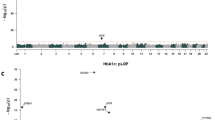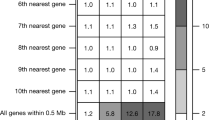Abstract
Introduction
A number of genes have been identified in which rare variants can cause obesity. Here we analyse a sample of exome sequenced subjects from UK Biobank using BMI as a phenotype with the aims of identifying genes in which rare, functional variants influence BMI and characterising the effects of different categories of variant.
Methods
There were 199,807 exome sequenced subjects for whom BMI was recorded. Weighted burden analysis of rare, functional variants was carried out, incorporating population principal components and sex as covariates. For selected genes, additional analyses were carried out to clarify the contribution of different categories of variant. Statistical significance was summarised as the signed log 10 of the p value (SLP), given a positive sign if the weighted burden score was positively correlated with BMI.
Results
Two genes were exome-wide significant, MC4R (SLP = 15.79) and PCSK1 (SLP = 6.61). In MC4R, disruptive variants were associated with an increase in BMI of 2.72 units and probably damaging nonsynonymous variants with an increase of 2.02 units. In PCSK1, disruptive variants were associated with a BMI increase of 2.29 and protein-altering variants with an increase of 0.34. Results for other genes were not formally significant after correction for multiple testing, although SIRT1, ZBED6 and NPC2 were noted to be of potential interest.
Conclusion
Because the UK Biobank consists of a self-selected sample of relatively healthy volunteers, the effect sizes noted may be underestimates. The results demonstrate the effects of very rare variants on BMI and suggest that other genes and variants will be definitively implicated when the sequence data for additional subjects becomes available.
This is a preview of subscription content, access via your institution
Access options
Subscribe to this journal
Receive 12 print issues and online access
$259.00 per year
only $21.58 per issue
Buy this article
- Purchase on SpringerLink
- Instant access to full article PDF
Prices may be subject to local taxes which are calculated during checkout

Similar content being viewed by others
Data availability
The raw data is available on application to UK Biobank. Detailed results with variant counts cannot be made available because they might be used for subject identification. Scripts and relevant derived variables will be deposited in UK Biobank. Software and scripts used to carry out the analyses are available at https://github.com/davenomiddlenamecurtis.
References
Müller MJ, Geisler C, Blundell J, Dulloo A, Schutz Y, Krawczak M, et al. The case of GWAS of obesity: does body weight control play by the rules? [Internet]. Vol. 42, Int J Obes. Nature Publishing Group; 2018 [cited 2021 Jan 13]. p. 1395–405. Available from: https://doi.org/10.1038/s41366-018-0081-6
Thaker VV. Genetic and epigenetic causes of obesity. Adolesc Med State Art Rev [Internet]. 2017 [cited 2021 Jan 13];28:379–405. Available from: http://www.ncbi.nlm.nih.gov/pubmed/30416642
Stutzmann F, Vatin V, Cauchi S, Morandi A, Jouret B, Landt O, et al. Non-synonymous polymorphisms in melanocortin-4 receptor protect against obesity: the two facets of a Janus obesity gene. Hum Mol Genet [Internet]. 2007 Aug 1 [cited 2021 Jan 13];16:1837–44. Available from: https://pubmed.ncbi.nlm.nih.gov/17519222/
Brouwers B, Oliveira EM de, Marti-Solano M, Monteiro FBF, Laurin S-A, Keogh JM, et al. Human MC4R variants affect endocytosis, trafficking and dimerization revealing multiple cellular mechanisms involved in weight regulation. Cell Rep [Internet]. 2021 Mar 23 [cited 2021 Sep 24];34. Available from: http://www.cell.com/article/S2211124721001765/fulltext
Curtis D. Multiple linear regression allows weighted burden analysis of rare coding variants in an ethnically heterogeneous population. Hum Hered [Internet]. 2020 Jan 7 [cited 2021 Jan 8];1–10. Available from: https://www.karger.com/Article/FullText/512576
Szustakowski JD, Balasubramanian S, Sasson A, Khalid S, Bronson PG, Kvikstad E, et al. Advancing human genetics research and drug discovery through exome sequencing of the UK Biobank. medRxiv [Internet]. 2020 Jan 1;2020.11.02.20222232. Available from: http://medrxiv.org/content/early/2020/11/04/2020.11.02.20222232.abstract
Curtis D. Analysis of 200,000 exome-sequenced UK Biobank subjects illustrates the contribution of rare genetic variants to hyperlipidaemia. J Med Genet [Internet]. 2021 Apr 28 [cited 2021 Apr 30];jmedgenet-2021-107752. Available from: https://doi.org/10.1136/jmedgenet-2021-107752
Curtis D. Analysis of rare coding variants in 200,000 exome-sequenced subjects reveals novel genetic risk factors for type 2 diabetes. Diabetes Metab Res Rev [Internet]. 2021 [cited 2021 Sep 24]; Available from: https://pubmed.ncbi.nlm.nih.gov/34216101/
Akbari P, Gilani A, Sosina O, Kosmicki JA, Khrimian L, Fang YY, et al. Sequencing of 640,000 exomes identifies GPR75 variants associated with protection from obesity. Science (80−) [Internet]. 2021 [cited 2021 Sep 24];373. Available from: https://doi.org/10.1126/science.abf8683
Curtis D. Exploration of weighting schemes based on allele frequency and annotation for weighted burden association analysis of complex phenotypes. Gene [Internet]. 2021 Oct [cited 2021 Nov 29];809:146039. Available from: https://pubmed.ncbi.nlm.nih.gov/34688815/
McLaren W, Gil L, Hunt SE, Riat HS, Ritchie GRS.Thormann A,et al. The ensembl variant effect predictor. Genome Biol [Internet]. 2016 Jun 6 [cited 2017 May 9]17:122. Available from: https://doi.org/10.1186/s13059-016-0974-4.
Adzhubei I, Jordan DM, Sunyaev SR. Predicting functional effect of human missense mutations using PolyPhen-2. Curr Protoc Hum Genet [Internet]. 2013[cited 2017 May 17];7 Unit7.20. Available from: http://www.ncbi.nlm.nih.gov/pubmed/23315928
Kumar P, Henikoff S, Ng PC. Predicting the effects of coding non-synonymous variants on protein function using the SIFT algorithm. Nat Protoc [Internet]. 2009 Jun 25 [cited 2017 May 17];4:1073–81. Available from: http://www.ncbi.nlm.nih.gov/pubmed/19561590
Chang CC, Chow CC, Tellier LC, Vattikuti S, Purcell SM, Lee JJ. Second-generation PLINK: rising to the challenge of larger and richer datasets. Gigascience [Internet]. 2015 Dec 25 [cited 2017 Sep 19];4:7. Available from: https://doi.org/10.1186/s13742-015-0047-8
Galinsky KJ, Bhatia G, Loh PR, Georgiev S, Mukherjee S, Patterson NJ, et al. Fast principal-component analysis reveals convergent evolution of ADH1B in Europe and East Asia. Am J Hum Genet [Internet]. 2016 Mar 3 [cited 2020 Dec 14];98:456–72. Available from: https://pubmed.ncbi.nlm.nih.gov/26924531/
Curtis D. A rapid method for combined analysis of common and rare variants at the level of a region, gene, or pathway. Adv Appl Bioinform Chem. 2012;5:1–9.
Curtis D. Pathway analysis of whole exome sequence data provides further support for the involvement of histone modification in the aetiology of schizophrenia. Psychiatr Genet [Internet]. 2016;26:223–7. http://content.wkhealth.com/linkback/openurl?sid=WKPTLP:landingpage&an=00041444-900000000-99634
Subramanian A, Tamayo P, Mootha VK, Mukherjee S, Ebert BL, Gillette MA, et al. Gene set enrichment analysis: a knowledge-based approach for interpreting genome-wide expression profiles. Proc Natl Acad Sci USA [Internet]. 2005;102:15545–50. http://www.ncbi.nlm.nih.gov/entrez/query.fcgi?cmd=Retrieve&db=PubMed&dopt=Citation&list_uids=16199517
R Core Team. R: A language and environment for statistical computing. [Internet]. Vienna, Austria.: R Foundation for Statistical Computing; 2014. Available from: http://www.r-project.org
Winkler TW, Justice AE, Graff M, Barata L, Feitosa MF, Chu S, et al. The influence of age and sex on genetic associations with adult body size and shape: a large-scale genome-wide interaction study. PLoS Genet [Internet]. 2015;11:1–42. https://pubmed.ncbi.nlm.nih.gov/26426971/
Jin P, Wu X, Xu S, Zhang H, Li Y, Cao Z, et al. Differential expression of six genes and correlation with fatness traits in a unique broiler population. Saudi J Biol Sci [Internet]. 2017 May 1 [cited 2021 Jan 18];24:945–9. Available from: https://doi.org/10.1016/j.sjbs.2015.04.014
Chang HC, Guarente L. SIRT1 and other sirtuins in metabolism. Vol. 25, Trends in Endocrinology and Metabolism. Elsevier Current Trends; 2014. p. 138–45.
Perrini S, Porro S, Nigro Pasquale, Cignarelli A, Caccioppoli C, Valentina, et al. Reduced SIRT1 and SIRT2 expression promotes adipogenesis of human visceral adipose stem cells and associates with accumulation of visceral fat in human obesity. Int J Obes [Internet]. 2020;44:307–19. Available from: https://doi.org/10.1038/s41366-019-0436-7
Liu X, Liu H, Wang M, Li R, Zeng J, Mo D, et al. Disruption of the ZBED6 binding site in intron 3 of IGF2 by CRISPR/Cas9 leads to enhanced muscle development in Liang Guang Small Spotted pigs. Transgenic Res [Internet]. 2019;28:141–50. https://pubmed.ncbi.nlm.nih.gov/30488155/
Younis S, Schönke M, Massart J, Hjortebjerg R, Sundström E, Gustafson U, et al. The ZBED6-IGF2 axis has a major effect on growth of skeletal muscle and internal organs in placental mammals. Proc Natl Acad Sci USA [Internet]. 2018 Feb 27 [cited 2021 Jan 18];115:E2048–57. Available from: https://pubmed.ncbi.nlm.nih.gov/29440408/
Zhang X, Jiang S, Mitok KA, Li L, Attie AD, Martin TFJ. BAI AP3, a C2 domain-containing Munc 13 protein, controls the fate of dense-core vesicles in neuroendocrine cells. J Cell Biol [Internet]. 2017 [cited 2021 Jan 18];216:2151–66. Available from: https://pubmed.ncbi.nlm.nih.gov/28626000/
Ribasés M, Gratacòs M, Armengol L, De Cid R, Badía A, Jiménez L, et al. Met66 in the brain-derived neurotrophic factor (BDNF) precursor is associated with anorexia nervosa restrictive type. Mol Psychiatry [Internet]. 2003 Jul 30 [cited 2021 Jan 19];8:745–51. Available from: www.nature.com/mp
Pulit SL, Stoneman C, Morris AP, Wood AR, Glastonbury CA, Tyrrell J, et al. Meta-Analysis of genome-wide association studies for body fat distribution in 694 649 individuals of European ancestry. Hum Mol Genet [Internet]. 2019 Jan 1 [cited 2021 Jan 19];28:166–74. Available from: https://pubmed.ncbi.nlm.nih.gov/30239722/
Xu Y, Zhang Q, Tan L, Xie X, Zhao Y. The characteristics and biological significance of NPC2: Mutation and disease. Vol. 782, Mutation Research - Reviews in Mutation Research. Elsevier B.V.; 2019. p. 108284.
Liu R, Zou Y, Hong J, Cao M, Cui B, Zhang H, et al. Rare loss-of-function variants in npc1 predispose to human obesity. Diabetes [Internet]. 2017;66:935–47. https://pubmed.ncbi.nlm.nih.gov/28130309/
Kogelman LJA, Pant SD, Fredholm M, Kadarmideen HN. Systems genetics of obesity in an F2 pig model by genome-wide association, genetic network, and pathway analyses. Front Genet [Internet]. 2014 [cited 2021 Jan 19];5(Jul). Available from: https://pubmed.ncbi.nlm.nih.gov/25071839/
Wade KH, Lam BYH, Melvin A, Pan W, Corbin LJ, Hughes DA, et al. Loss-of-function mutations in the melanocortin 4 receptor in a UK birth cohort. Nat Med 2021 276 [Internet]. 2021 May 27 [cited 2021 Sep 24];27:1088–96. Available from: https://www.nature.com/articles/s41591-021-01349-y
Acknowledgements
This research has been conducted using the UK Biobank Resource. The author wishes to acknowledge the staff supporting the High Performance Computing Cluster, Computer Science Department, University College London. This work was carried out in part using resources provided by BBSRC equipment grant BB/R01356X/1. The author wishes to thank the participants who volunteered for the UK Biobank project.
Author information
Authors and Affiliations
Corresponding author
Ethics declarations
Competing interests
The author declares no competing interests.
Additional information
Publisher’s note Springer Nature remains neutral with regard to jurisdictional claims in published maps and institutional affiliations.
Supplementary information
Rights and permissions
About this article
Cite this article
Curtis, D. Weighted burden analysis in 200,000 exome-sequenced subjects characterises rare variant effects on BMI. Int J Obes 46, 782–792 (2022). https://doi.org/10.1038/s41366-021-01053-4
Received:
Revised:
Accepted:
Published:
Issue Date:
DOI: https://doi.org/10.1038/s41366-021-01053-4
This article is cited by
-
Mutational landscape of risk variants in comorbid depression and obesity: a next-generation sequencing approach
Molecular Psychiatry (2024)



